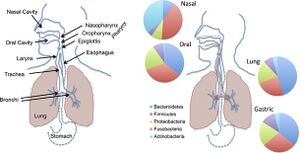The Lung Microbiome and its Correspondence with Asthma
Introduction
The gut microbiome, an abundant microbial community that houses more than 1000 bacterial species[1], is a highly researched and reviewed topic. However, in recent years, scientists have begun to study areas in the body where other microbiomes exist, like the lungs. Researchers have discovered that the lung microbiome, a microbial community in the lower respiratory tract, is 1) matured and 2) metabolically active. The lung microbiome in its entirety consists of its microorganisms (bacteria, archea, eukaryotes, viruses), their genes, and the external environmental conditions of the lungs[1]. In comparison to other microbial communities, the lung microbiome is modest in size, and provides some difficulties when attempting to retrieve samples. In its specific relation to asthma, the most commonplace chronic respiratory disease, the lung microbiome effects both the endotypes [2]and phenotypes of asthma. An infection of a host body is usually followed by an increase in gammaproteobacteria, which includes gram-negative bacteria that can resistance certain antibiotics and releases molecules in the lungs that trigger inflammation. When the body experiences inflammation, it increaases the amount of blood flow and mucus, which is nutrients for gammaproteobacteria. Therefore, gammeaproteobacteria increases reproduction as the environmental conditions of inflammation increase, causing a cyclical inflammatory mechanism [3]

At right is a sample image insertion. It works for any image uploaded anywhere to MicrobeWiki. The insertion code consists of:
Double brackets: [[
Filename: PHIL_1181_lores.jpg
Thumbnail status: |thumb|
Pixel size: |300px|
Placement on page: |right|
Legend/credit: Electron micrograph of the Ebola Zaire virus. This was the first photo ever taken of the virus, on 10/13/1976. By Dr. F.A. Murphy, now at U.C. Davis, then at the CDC.
Closed double brackets: ]]
Other examples:
Bold
Italic
Subscript: H2O
Superscript: Fe3+
I don't know
Section 1 Genetics
Include some current research, with at least one image.
Sample citations: [4]
[5]
A citation code consists of a hyperlinked reference within "ref" begin and end codes.
Section 2 Microbiome
Include some current research, with a second image.
Conclusion
Overall text length should be at least 1,000 words (before counting references), with at least 2 images. Include at least 5 references under Reference section.
References
- ↑ 1.0 1.1 Loverdos, Konstantinos et al. “Lung Microbiome in Asthma: Current Perspectives.” Journal of clinical medicine vol. 8,11 1967. 14 Nov. 2019, doi:10.3390/jcm8111967
- ↑ [Wikipedia contributors. "Endotype." Wikipedia, The Free Encyclopedia. Wikipedia, The Free Encyclopedia, 8 Jul. 2021. Web. 5 Nov. 2021.]
- ↑ Huffnagle, G B, et al. “The Respiratory Tract Microbiome and Lung Inflammation: A Two-Way Street.” Nature News, Nature Publishing Group, 14 Dec. 2016, https://www.nature.com/articles/mi2016108.
- ↑ Hodgkin, J. and Partridge, F.A. "Caenorhabditis elegans meets microsporidia: the nematode killers from Paris." 2008. PLoS Biology 6:2634-2637.
- ↑ Bartlett et al.: Oncolytic viruses as therapeutic cancer vaccines. Molecular Cancer 2013 12:103.
- ↑ Lee G, Low RI, Amsterdam EA, Demaria AN, Huber PW, Mason DT. Hemodynamic effects of morphine and nalbuphine in acute myocardial infarction. Clinical Pharmacology & Therapeutics. 1981 May;29(5):576-81.
Edited by Margo Moceyunas, student of Joan Slonczewski for BIOL 116 Information in Living Systems, 2020, Kenyon College.
